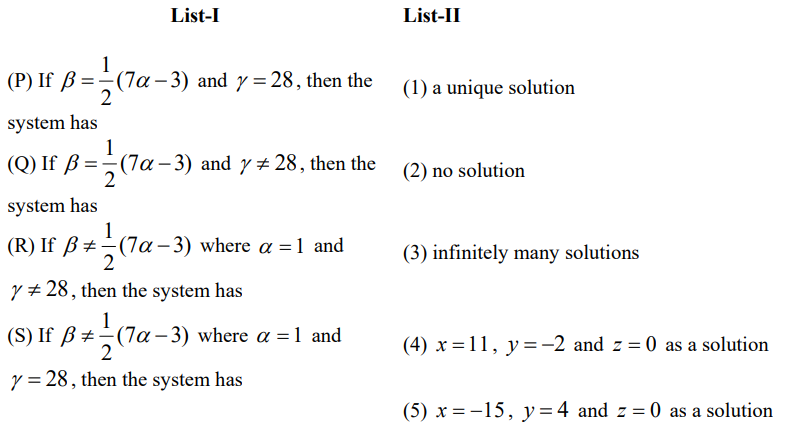Let α,βandγ be real numbers such that the system of linear equations
x+2y+3z=α
4x+5y+6z=β
7x+8y+9z=γ−1
Let P be the plane containing all those (α,β,γ) for which the above system of linear
equations is consistent, and D be the square of the distance of the point (0,1,0) from the plane P.
The value of |M| is ______
To solve the problem, we need to analyze the system of linear equations given and find the conditions under which they are consistent. Let's break down the solution step by step.
Step 1: Write the system of equations in matrix form
The system of equations can be represented in matrix form as follows:
⎡⎢⎣123456789⎤⎥⎦⎡⎢⎣xyz⎤⎥⎦=⎡⎢⎣αβγ−1⎤⎥⎦
Step 2: Find the determinant of the coefficient matrix
To determine if the system is consistent, we need to find the determinant of the coefficient matrix:
D=∣∣
∣∣123456789∣∣
∣∣
Calculating this determinant, we can use the rule of Sarrus or cofactor expansion. Here, we can observe that the rows are linearly dependent (the third row is a linear combination of the first two), so:
D=0
Step 3: Set up the condition for consistency
For the system to be consistent, the augmented matrix must also have a determinant of zero. This leads us to the condition:
α+2β+3(γ−1)=0
Rearranging gives:
α+2β+3γ−3=0⟹α+2β+3γ=3
Step 4: Identify the plane P
The equation α+2β+3γ=3 represents a plane in the (α,β,γ) space.
Step 5: Find the distance from the point (0, 1, 0) to the plane P
The distance D from a point (x0,y0,z0) to the plane Ax+By+Cz+D=0 is given by:
D=|Ax0+By0+Cz0+D|√A2+B2+C2
For our plane, we can rewrite it as:
α+2β+3γ−3=0
Here, A=1, B=2, C=3, and D=−3. The point is (0,1,0):
D=|1(0)+2(1)+3(0)−3|√12+22+32=|2−3|√1+4+9=1√14
Step 6: Calculate the square of the distance
The square of the distance D2 is:
D2=(1√14)2=114
Step 7: Find the value of absM
The value of absM is the square of the distance D2:
absM=114
Final Answer
Thus, the value of absM is:
114
The system of equations can be represented in matrix form as follows:
To determine if the system is consistent, we need to find the determinant of the coefficient matrix:
∣∣123456789∣∣
∣∣
For the system to be consistent, the augmented matrix must also have a determinant of zero. This leads us to the condition:
The equation α+2β+3γ=3 represents a plane in the (α,β,γ) space.
The distance D from a point (x0,y0,z0) to the plane Ax+By+Cz+D=0 is given by:
The square of the distance D2 is:
The value of absM is the square of the distance D2:
Thus, the value of absM is:
Topper's Solved these Questions
Similar Questions
Let α,βandγ be real numbers such that the system of linear equations
x+2y+3z=α
4x+5y+6z=β
7x+8y+9z=γ−1
Let P be the plane containing all those (α,β,γ) for which the above system of linear equations is consistent, and D be the square of the distance of the point (0,1,0) from the plane P.
The value of D is ______
View SolutionLet α,βandγ be real numbers. Consider the following system of linear equations
x+2y+z=7
x+αz=11
2x−3y+βz=γ
Match each entry in List-I to the correct entries in List-II.

The correct option is:
View Solution
Knowledge Check
Consider the system of equations :
x + y + z = 0
αx+βy+γz=0
α2x+β2y+γ2z=0
then the system of equations hasAa unique solution for all values of α,β,γBinfinite number of solutions if any two of α,β,γ are equalCa unique solution if α,β,γ are distinctDmore than one,but finite number of solutions depending on values of α,β,γIf the system of linear equations :
x+4y-3z=2
2x+7y+4z=α
-x-5y+5z=β
has infinitely many solutoins than the ordered pair (α,β) cannot take value :A(4,-2)B(2,-4)C(3,-3)D(-3,3)An ordered pair (α,β) for which the system of linear equations
(1+α)xβy+z=2
αx+(1+β)y+z=3
αx+βy+2z=2
has a unique solution, isA(2, 4)B(−4,2)C(1,−3)D(−3,1)
If x =α,y=β,z=γ is a solution of the system of equations
x+y+z=4
2x-y+3z=9
View SolutionIf α+β+γ=2π, then the system of equations
x+(cosγ)y+(cosβ)z=0
(cosγ)x+y+(cosα)z=0
(cosβ)x+(cosα)y+z=0
has :
View SolutionFor real numbers αandβ, consider the following system of linear equations: x+y−z=2,x+2y+αz=1,2x−y+z=β. If the system has infinite solutions, then α+β is equal to ____
View SolutionIf α,β,γ are the cube roots of p,p<0 then for any x, y and z
xα+yβ+zγxβ+yγ+zα =
View SolutionIf the system of linear equations
x+4y−3z=2
2x+7y−4z=α
−x−5y+5z=β
has infinitely many solutions then the ordered pair (α,β) cannot take value
View Solution
